Results of observations with the 70cm KING telescope at the MPIA on the Königstuhl near Heidelberg, Germany
The observations are ordered chronologically, with the first observation done in September 2004. To obtain a larger view of the objects, click on the images. The objects observed so far are:
- 2004-09-17: Planetary Nebula NGC 7048
- 2004-09-18: Edge on Spiral Galaxy NGC 891
- 2004-09-18: Crab Nebula (M 1)
- 2005-06-18: Dumbbell Nebula (M 27)
- 2005-10-27: Spiral Galaxy NGC 7331
- 2005-10-27: Face on Spiral Galaxy M 74
- 2005-10-30: Globular Cluster M 15
- 2005-10-30: Triangulum Galaxy (M 33)
- 2005-09-09: IC342
- 2005-10-30: Stephan's Quintet
- 2005-09-09: NGC 1068 (M 77)
Planetary Nebula NGC 7048
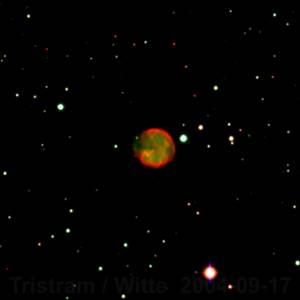 |
The image of NGC 7048 was obtained on September 17th, 2004, with a Tektronix TK1024 CCD by Malte Witte and myself. The image is a composite of three filterbands: B, Hα and O[III]. The integration times were 10×60 sec for B, 6×120 sec for Hα and 6×120 sec for O[III]. The seeing was about 2 arcsec during the observation night. The nebula has a size of approximately one arcminute. NGC 7048 is a planetary nebula in the constellation of Cygnus.
Edge on Spiral Galaxy NGC 891
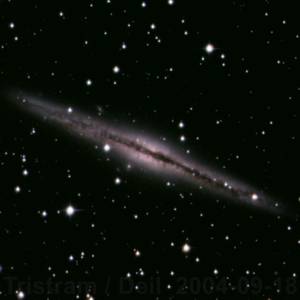 |
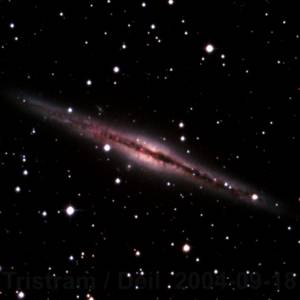 |
These images show the edge-on spiral galaxy NGC 891 in the constellation of Andromeda. The data was obtained on September 18th, 2004, with a Tektronix TK1024 CCD by Christoph Deil and myself. The left image is a colour composite from the filterbands B, V and R. In the right image, the R band frame was replaced by observations with the Hα filter. The integration times were 10×60 sec in the broad band filters B, V and R and 6×300 sec in Hα. The observations were made with a seeing of about 2 arcsec. The galaxy is about 13 arcmin long and 3 arcmin wide. There are two companion galaxies visible, one below and one above the disk.
Crab Nebula (M 1)
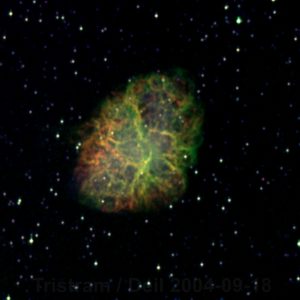 |
Christoph Deil and me also observed the Crab Nebula (M 1, NGC 1952) on September 18th, 2004. The image above is a composite of three filterbands: B, Hα and O[III]. The integration times were 10×30 sec for B, 6×60 sec for Hα and 6×100 sec for O[III]. The seeing degraded significantly from the previous observations of NGC 891: it varied between 3 and 3.5 arcsec. Actually the degradation of the seeing reflected the approach of a bad weather front. The point spread functions in the combined frames showed some elongation due to inaccuracies in the telescope drive at this pointing. This artefact can still be seen in the very bright star at the top right. To overcome this effect, I tried a mild deconvolution of the images using the Lucy-Richardson image restoring algorithm. The Crab nebula is the most famous supernova remnant, located in the constellation of Taurus.
Dumbbell Nebula (M 27)
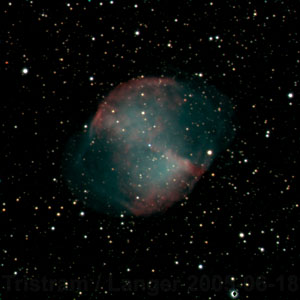 |
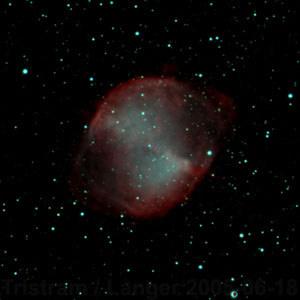 |
The Dumbell Nebula (M 27, NGC 6853) displayed above is a planetary nebula in the constellation of Vulpecula. I observed this object together with Andrea Langer on June 18th, 2005 with the new Loral / Lesser LOR 2048×2048 detector attached to the KING telescope. The chip was read out with a binning of 2 in both x and y directions. The integration times were 12×150 sec for B, 10×150 sec for V, 10×120 sec for R and 5×150 sec for Hα. The seeing during the observations was about 3 arcsec. The left image is a composite of the B, V and R filters, while in the image on the right the R band was replaced by the Hα image. The bright region has a size of approximately 6 arcminutes in North-South direction. The nebula was ejected about 3000 years ago by the bluish star visible in the centre of the object. Because the ejected gas emits strongly in Hα all the stars appear to be comparitively blue in the right Hα image.
Spiral Galaxy NGC 7331
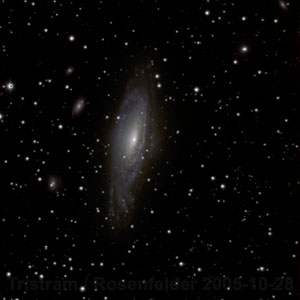 |
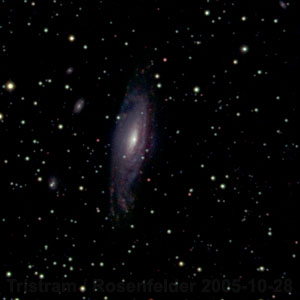 |
This spiral galaxy was observed on 27th and 28th of October 2005 together with Ingrid Rosenfelder. The Loral / Lesser LOR 2048×2048 detector was used with a binning of 2. The galaxy was observed in B, V, R filters in the first night and in O[III] and Hα in the second night with intergration times of 10×100 sec for the broad band filters and 6×300 sec for the two narrow band filters. The seeing degraded from 2.8 arcsec in the first night to 3.9 arcsec in the second night. The image on the left is composed of the B, V and R data, while the right images contains the B, O[III] and Hα data. A few HII regions appear as several red blobbs in the disc of the galaxy in the right image. The three smaller galaxies to the East (to the left) of NGC 7331 are NGC 7335, NGC 7336 and NGC 7337, the galaxy in the top right corner is NGC 7325. NGC 7331 has a size of 2.5×8.0 arcsecs and is a LINER-type active galaxy, which is located about 50 million light-years away in the constellation of Pegasus.
Face on Spiral Galaxy M 74
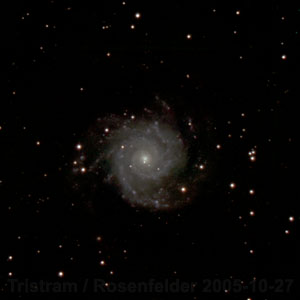 |
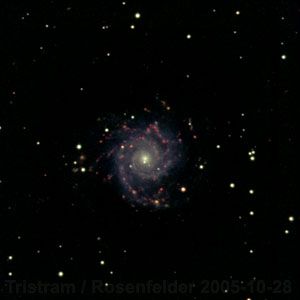 |
In the same nights Ingrid and I observed NGC 7331 we later also observed M 74 (NGC 0628) in the constellation of Pisces. The integration times are the same as for NGC 7331 (10×100 sec for B, V, R and 6×300 sec for O[III], Hα) and the seeing conditions were similar: 2.8 arcsec on October 27th (B and V) and 3.5 arcsec on October 28th (R, O[III] and Hα). The left is a composite of B, V and R while the right image is the B, O[III], Hα composite. M 74 is a prototype grand-design spiral galaxy classified as Sc . The disc of the galaxy contains several star clusters (appearing as bluish blobbs in the left image - the bright points are foreground stars) and HII regions which can be seen best in the right image. The two green sources to the East (i.e. to the left) are very strong in O[III] emission, but I haven't found anything on their special nature. So if anyone knows, please contact me!
Globular Cluster M 15
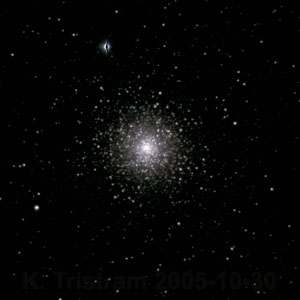 |
Because the observations of NGC 7331 and M74 two nights earlier were so successful, I continued with M 15 (NGC 7078) and M 33 (NGC 0598, see below) on October 30th, 2005. I observed M 15 in the B, V and R filter with 15×60 sec exposures for every filter. The seeing varied between 3.2 arcsec and 3.9 arcsec. M 15 is located in the constellation of Pegasus at a distance of 10 kpc. The size is about 6 arcmin. The bright object to the North is a star, HD 204712, which is heavily saturated and therefore produces several bad columns on the detector.
Triangulum Galaxy (M 33)
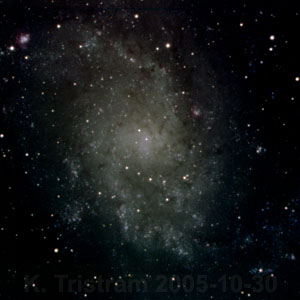 |
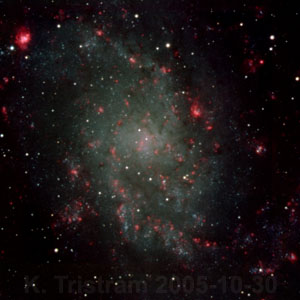 |
The Triangulum Galaxy (M 33, NGC 0598) was also observed on the 30th of October 2005, with a Loral / Lesser LOR 2048×2048 detector (binning 2) under rather bad seeing conditions of 3.3 to 4.0 arcsec. The integration times were 19×60 sec for B, 17×60 sec for V, 18×60 sec for R and 6×240 sec for Hα. The left image shows a composite from the B, V and R filters, while the right is a composite of B, V and Hα. M 33, located in the constellation of Triangulum, is a member of the local group to which also our own Milky Way belongs. That is why it has a size of 70×40 arcmin, which is much larger than the area covered by the detector used. The images above only show the central region with a size of 20 arcmin.
IC 342
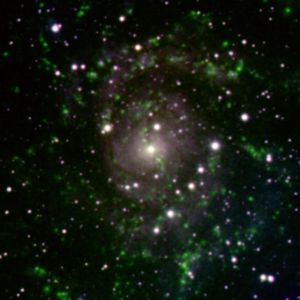 |
After a pause of almost a year I managed to observe again: Together with Felix Hormuth I observed the giant spiral galaxy IC 342 on September 9th, 2006. Although there was strong wind, the atmospheric conditions weren't too bad (seeing less than 3 arcsec). However the sky was very bright due to the moon. We obtained 9 exposures of 240 sec in V, 6 exposures of 300 sec in Hα and 10 exposures of 120 sec in R with the Loral / Lesser LOR 2048×2048 detector (binning 2). In the image above Hα was mapped to the green channel. It clearly traces the star forming regions in the spiral arms. The galaxy with a low surface brightness is classified as Sbc and located in Camelopardalis. The entire galaxy is more than 22 arcmin in size, our image only covers an area of 12.3×12.3 arcmin.
Stephan's Quintet (NGC 7317, NGC 7318A, NGC 7318B, NGC 7319, NGC 7320, NGC 7320C)
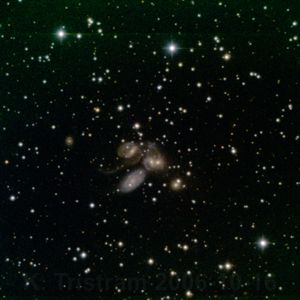 |
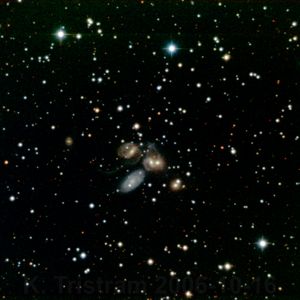 |
Stephan's Quintet was observed in B, V, and R band on October 16th, 2006 together with Christoph Deil and in the following night also in I band together with Aurora Sicilia-Aguilar. Conditions were fair with a seeing of about 2.5 to 3.0 arcsec. The integration times were 12×150 sec for B, 10×120 sec for V, 9×120 sec for R and 11×120 sec for I. The left image shows the BVR composite, the right one is the BVI composite (including a slightly more agressive image manipulation). Stephan's Quintet is located in the constellation of Pegasus and is composed of the five galaxies (NGC 7317, NGC 7318A&B, NGC 7319, NGC 7320 and NGC 7320C). The bluer galaxy (NGC 7320) is located closer to us than the other galaxies, which are strongly interacting at a distance of ~ 90 Mpc. The spiral galaxy to the North-East (top left, with the tidal tails), NGC 7319, has a Seyfert 2 nucleus. A bit further to the North-East NGC 7320C can be seen. The images show a region with a size of 18 arcmin.
NGC 1068 (M 77)
 |
In the same night (October 16th, 2006) Christoph Deil and me also observed the famous Seyfert 2 galaxy NGC 1068 (M 77). The exposure times were 10×150 sec for B, 11×120 sec for V and 10×120 sec for I, all with the Loral / Lesser LOR 2048×2048 detector and a binning of 2. This image covers an area of 16.5 arcmin. NGC 1068 is located at a distance of 14.4 Mpc in Cetus. The galaxy hosts an actively accreting supermassive black hole in its nucleus. This and its brightness in the mid infrared (MIR at λ=10µm) make it also a scientifically interesting target for me. Actually, it is the brightest target in the list of galaxies observed with MIDI and a big brother of the Circinus galaxy, whose nucleus I study for my PhD thesis. There are at least 10 additional faint galaxies visible in the frame.
